
Japan is the country for shopping, and if you are going for your first time on possibly a trip of a lifetime, then you will be planning to bring back a lot of stuff.
And who can blame you? Japan is full of cool stuff, tax-free shopping and all manner of knick-knacks! However, Japan isn’t exactly suitcase-friendly, it is quite tiny suitcase-friendly but decidedly not large suitcase-friendly.
It is one thing to say that you should pack lightly, arriving in Japan with a light suitcase isn’t exactly a showstopper, but as your trip goes on your suitcase will get heavier and heavier, and at some point you will start considering a second suitcase or another bag, and then life becomes increasingly difficult!
It is unavoidable that you may be lugging around a heavy suitcase or two, especially as you get to the end of your trip, so before you go to Japan it is best to check out our handy tips on what to do with luggage in Japan, that way you are sure to have a successful visit and get some heavy-duty shopping in too!
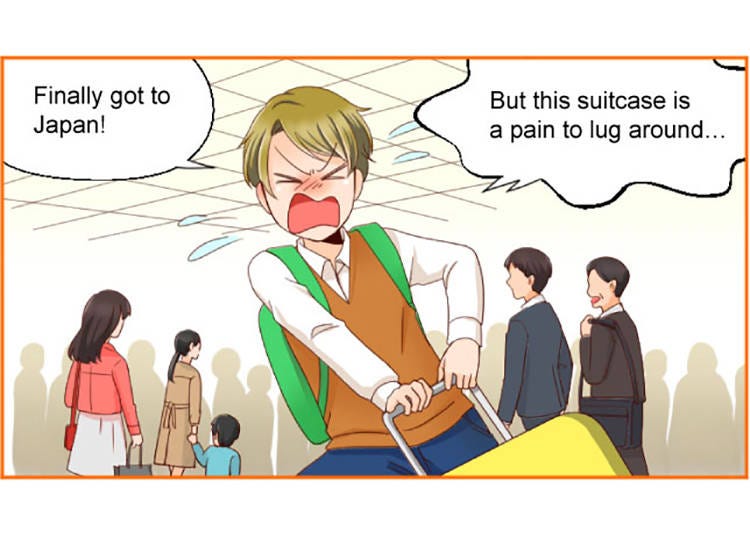

Handling Luggage on Transportation
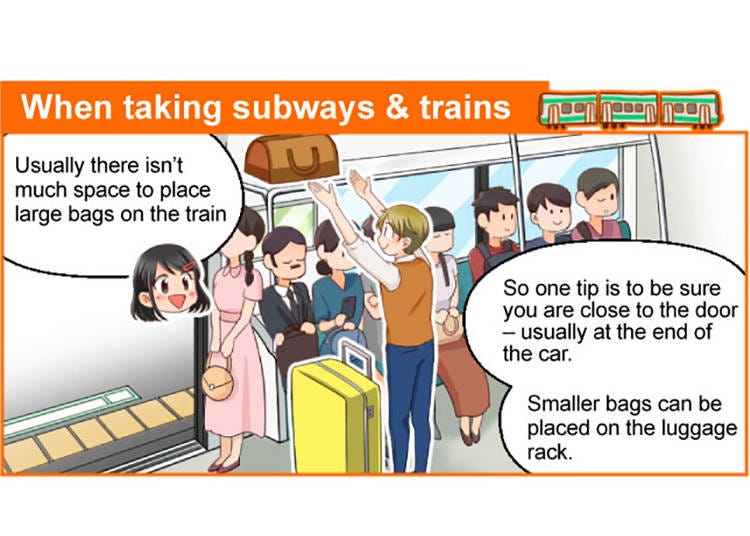
Trains
■ Subways and Trains
Generally there is no dedicated luggage space, so you have to watch out for getting seats by the carriage doors and parking your suitcase or bags in the small space between the door and the seating. Usually there is overhead space for small suitcases and bags. On many trains the very first and very last carriages have a large space for standing customers, and the last carriage will normally also have a buggy space. As the buggy space is often unused it is a great place for suitcases – though be careful to move your luggage if a parent with a buggy does appear.

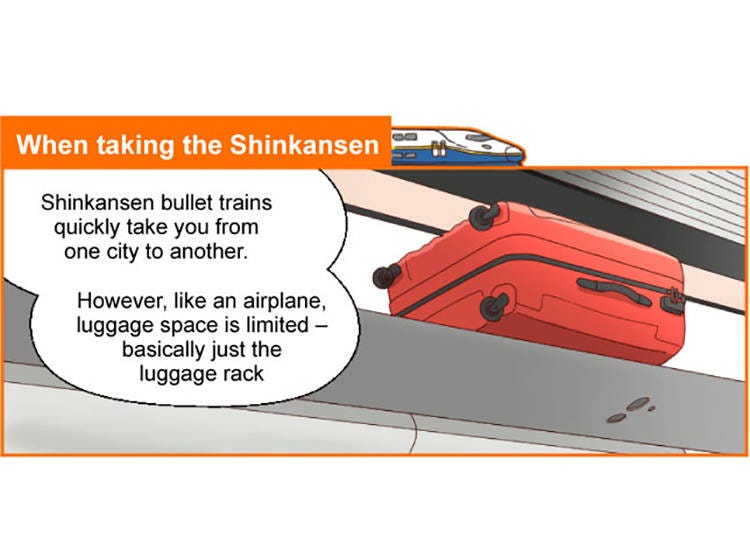
■ Shinkansen
Quite ironically considering that shinkansen trains can whisk you from one end of the country to the other, these trains are not friends to people travelling with large suitcases. There is no dedicated area for luggage and only space for small suitcases and bags overhead. However, in every carriage the very back and the very front seats have a little extra space and are the best places to plonk your stuff. Even if someone is sitting in the very back seats if the space behind them is empty then you can still put your luggage there – even a very large suitcase will fit. If you are staying in major hotels then it is recommended that you request the hotel to deliver your luggage to your next hotel for a fee instead.
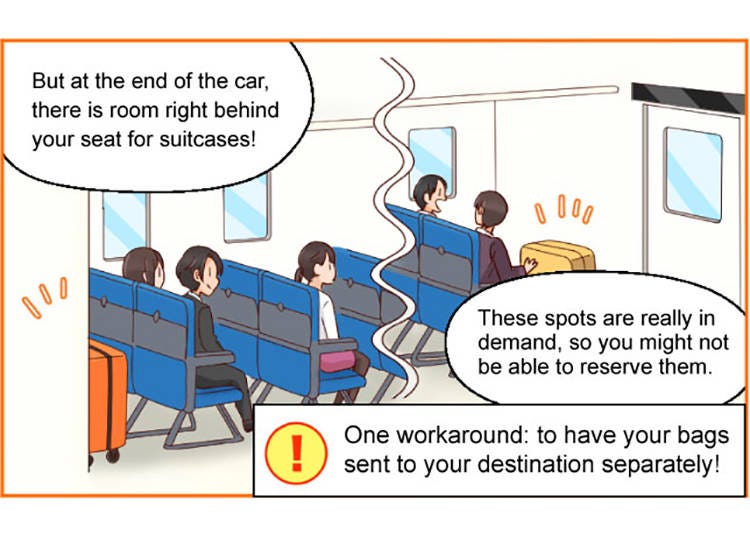
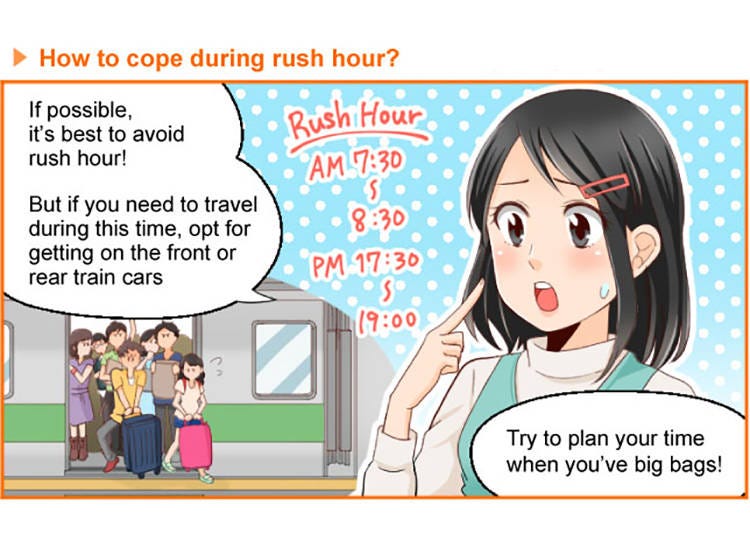
■ Advice for during rush hour
It is really best just not to travel with a big suitcase during rush hour, but if you absolutely have to then aim for the very front or back carriages. Try to give yourself plenty of time so that you aren’t stressing out that you can’t get on a train. Where possible try to use other forms of transport.
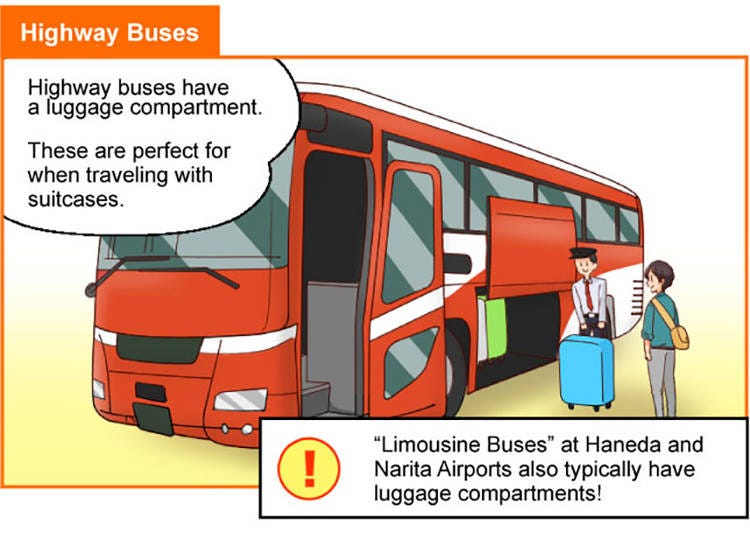
On Buses
■ Highway buses
In contrast to the shinkansen these have been designed with travelers in mind, usually there is plenty of space in the luggage compartment below deck as most Japanese travelers only have a small suitcase. Above your seat you can put a small bag. Buses to and from the airport also have ample space for suitcases.
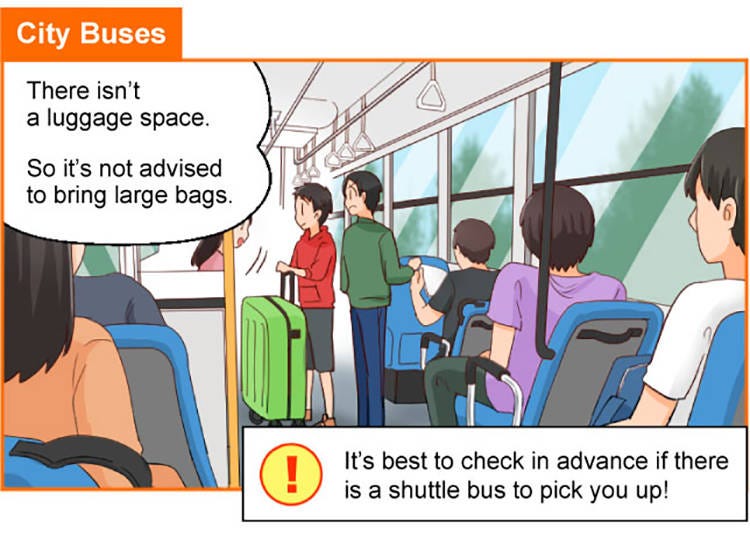
■ City buses
City buses are generally just not a good idea if you have large or a lot of luggage, they can be quite compact, and sometimes very small. There will be extremely limited space for baggage, and as buses are frequently used by local residents it can be a source of annoyance for them that people try to use local buses for their things. Where possible try to use a taxi, which can be inexpensive for short distances, or other forms of transportation. It is also worth checking whether your hotel is running a free bus as these normally have dedicated luggage space.
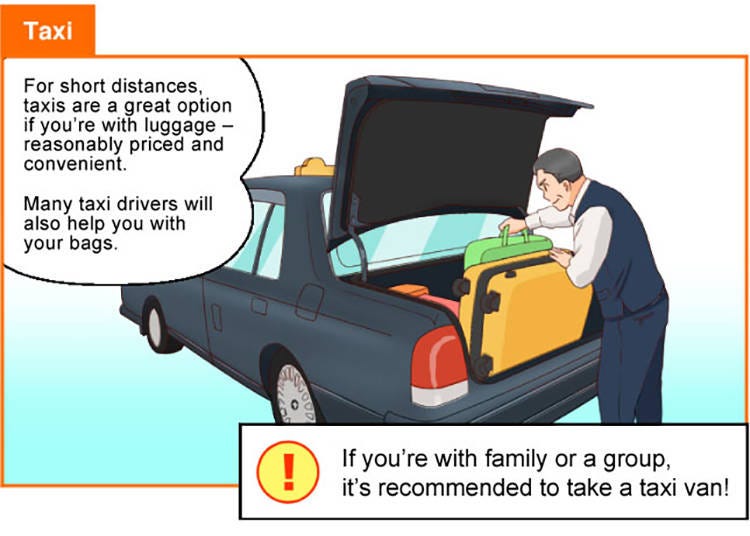
Taxis
Taxis are clean, with helpful drivers and as prices are fixed you can be sure you won’t be taken advantage of. Prices are quite reasonable for short distances and a taxi will often be far more convenient then a local bus, and you can be sure that your luggage will fit! As such most Japanese people opt to use a taxi when travelling with large suitcases.
Taxis always have amazingly large trunks, and in a worst case scenario can even put a suitcase in the front passenger seat too. They can normally fit in a couple of large suitcases, or a large suitcase, a medium suitcase and small bags. There are also minivans and larger cabs as well which can accommodate more bags than usual when traveling with family.
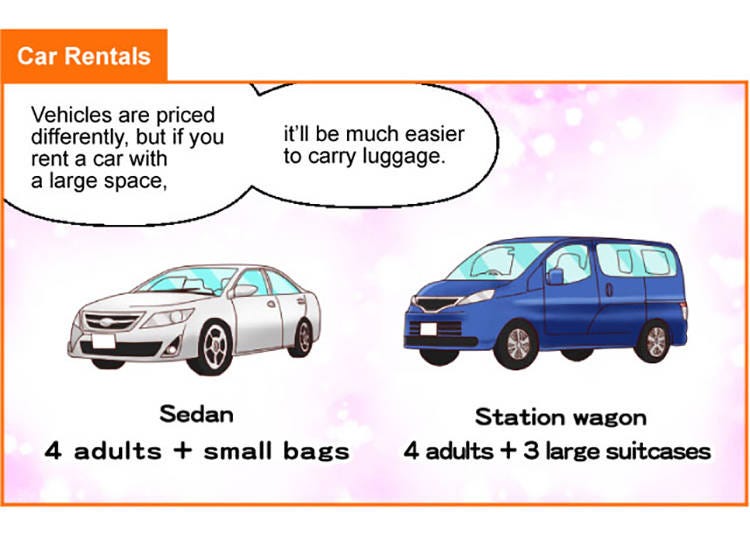
Rental cars
The kind of car you will get will depend on how much you are paying. With a small sub-compact car you won’t have a great deal of space. Whereas progressively bigger cars will have more space, to a certain extent you have to choose a car which is suitable for the number of passengers and the amount of luggage you plan to take.
For the smallest cars you will just be able to fit one large suitcase or a couple of small ones while with larger cars, with three passengers for example, you can fit a couple of large suitcases or three small pieces of luggage. If you rent a sedan then you can fit four passengers and two large suitcases. With station wagons, SUVs and minivans you can easily get in at least three large suitcases with four passengers.
Storing Luggage
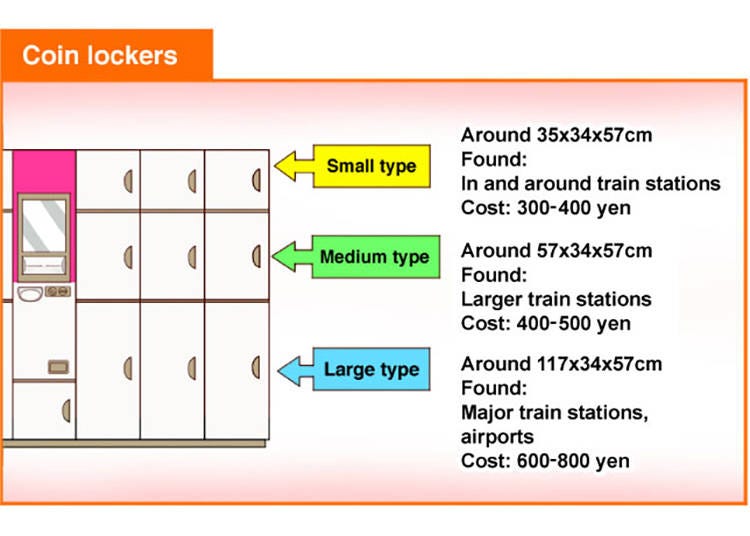
Coin lockers
■ How big are coin lockers in Japan?
・Small: approx. 35cm x 34cm x 57cm (13in x 13in x 22in). Available at most stations.
・Medium: approx. 57cm x 34cm x 57cm (22in x 13in x 22in). Fewer available in stations.
・Large: approx. 117cm x 34cm x 57cm (44in x 13in x 22in). Very few available in stations.

■ Where to find coin lockers in Japan
In many stations of a certain size you will normally find lockers somewhere and correspondingly the bigger the station the more lockers you are likely to find. For example in Shinjuku Station there are more than 3,500 lockers, but unfortunately these are mostly small lockers. In the same station there are only 266 large or bigger lockers. Generally lockers in every station are well signposted, and in a few stations like Shinjuku there is a Suica Coin Locker Search terminal which can tell you where your nearest available locker is.
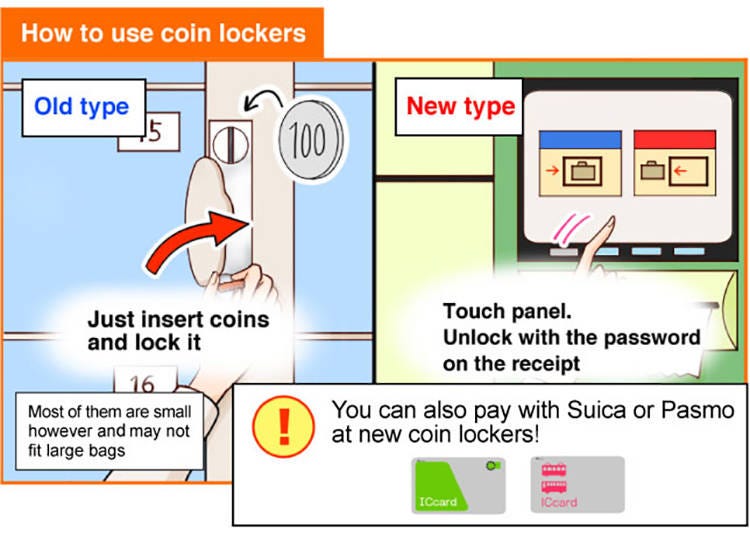
■ How to use a coin locker in Japan
There are a number of old-style and new-style locker types, for example there is a key-type locker which just needs 100 yen payment and then for the key to be turned. The key has a number and location written on it. A touchscreen-type locker works with a touchscreen, and you can pay by cash and get a PIN code with your receipt or access the locker by card if you make payment by Suica or PASMO.
■ How to pay
Lockers can be paid for with coins, or with the more advanced versions, with Suica or PASMO.
■ Approximate prices and how long bags can be stored
Fees can vary from place to place but generally for one day a small locker is 300-400 yen, a medium locker is 400-500 yen and a large locker is 600-800 yen. In most places you can only keep the locker for a maximum of three days, so it is really important to keep that in mind if you want to leave your luggage for a while.
If you can’t find a locker or need somewhere for a few days then try a third party luggage services such as ecbo cloak. This website connects people who want to drop their luggage off somewhere with shops, cafes, etc, which are happy to keep luggage for a fee.

● Tip on Temporary storage
Generally hotels and hostels are happy to hold luggage for travelers, though this can depend on the place and how much space they have. However, especially for hotels it shouldn’t be any problem to drop your luggage off before check-in as well as leave it after check-out. Again, it depends on the hotel but it’s not unheard of for a hotel to be willing to keep luggage for several days after check-out.
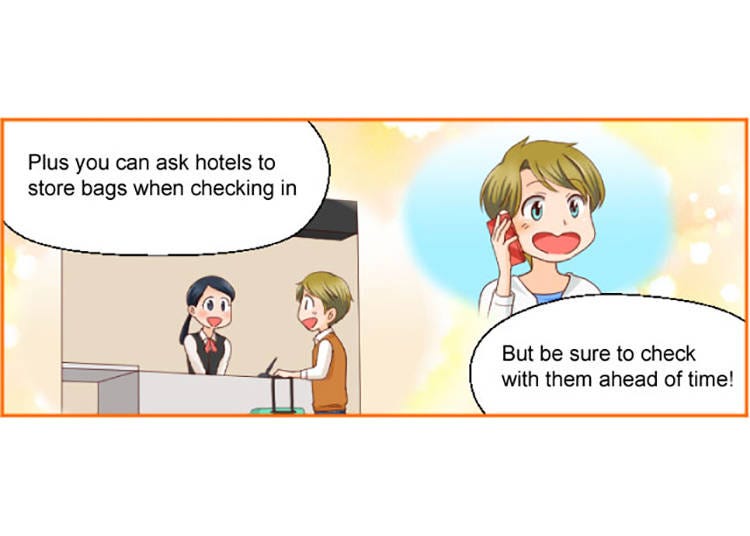
Luggage delivery
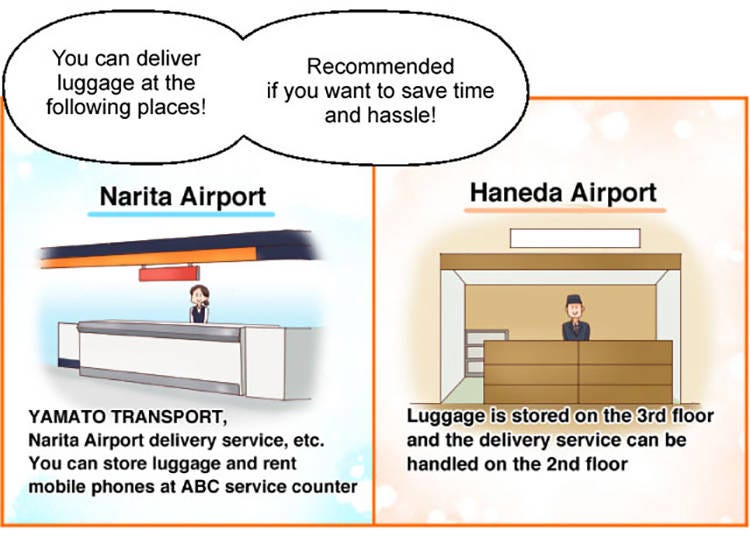
To/From airport
In all major, and some minor airports there is a delivery counter for luggage, this is extremely handy as you can arrive in Japan and immediately arrange for your luggage to be taken to your hotel for a fairly small fee (1,000-4,000 yen), and vice versa arrange for your luggage to be collected from your hotel and taken to the airport.
■ Narita Airport (NRT)
If you wish to collect luggage you can do so at the GPA delivery service counter on the international arrival floor (1st Floor) in Terminal 2 or the ABC delivery service counter on the international departure floor (3rd Floor) in Terminal 2. For sending your luggage to your hotel you can find various delivery service companies scattered around the terminals including KTC, Yamato and JAL.
■ Haneda Airport (HND)
At Haneda airport luggage can be collected from one of two service desks on the 3rd floor and you can arrange for luggage to be delivered using a service desk on the 2nd floor.
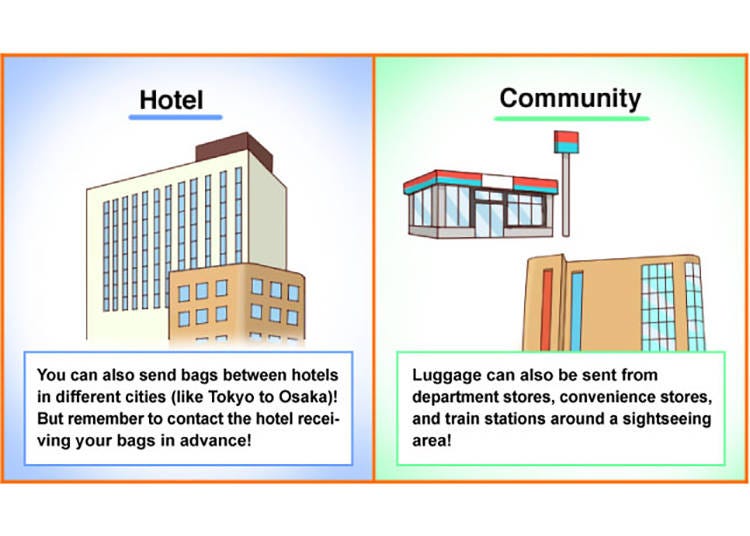
Between hotels
Most major hotels and business hotels are happy to arrange delivery of your suitcases to your next hotel. You will simply need to ask at reception, or check with the concierge, regarding whether this service is available and how much it will cost. It is also a good idea to ask them to contact your next hotel to forewarn them that your luggage will be delivered. Prices will depend on the size of your luggage, where it is going and whether you want regular or express delivery.
Between cities - Using takuhaibin
Outside of hotels you can also arrange luggage transportation at hands-free travel service counters, these can be found in tourist information centers, department stores as well as stations, etc. Yamato Transport also has a service called Takuhaibin and they can transport literally anything including furniture. You can arrange this service at any convenience store or other shop which has a Takuhaibin sign. For a large suitcase which is less than 25 kg it costs 1900 yen to deliver from Tokyo to Kyoto, and even just 3900 yen to deliver from Tokyo to Okinawa. It isn’t very much money, and will save you from the stress of carrying heavy luggage!

Illustrations courtesy of Manga de Japan
*Prices and options mentioned are subject to change.
*Unless stated otherwise, all prices include tax.
Recommended places for you
-
Appealing

Rukku and Uohei
Izakaya
Sapporo / Chitose
-

LakeAkan
Rivers, Lakes & Canyons
Abashiri
-
Appealing

Shirogane Blue Pond (Aoiike)
Rivers, Lakes & Canyons
Furano / Biei / Sounkyo
-
Appealing

Noboribetsu Onsen
Hot Springs (Onsen) & Bath Houses (Sento)
Noboribetsu / Lake Toya
-
Appealing

Mt. Hakodate Observatory
Forests & Mountains
Hakodate
-
Appealing

Asahiyama Zoo
Zoos, Aquariums & Botanical Gardens
Asahikawa
-

This Japanese train station has its very own hot spring bathhouse, right on the platform【Photos】
-

Safe and Comfortable Summer in Japan! Sunscreen, Cooling Hacks & Other Child-Friendly Summer Essentials
by: Chehui Peh
-

Spray Your Shirt Cold?! Japan's Smartest Sweat-Fighting Hacks You Can Buy at Don Quijote
by: Chehui Peh
-

'They Do What in the Toilet?!' Italians Shocked By These Japanese Beauty Quirks
by: Yuu Sato
-

'Is It Really Clean If...' 10 Things That Shocked an American Woman About Japan
-

Hachiji juppun mae – A Japanese phrase that even Japanese people can’t agree on the meaning of
-

These 16 Things to Do in Hakodate Japan Will Make You Fall in Love With the Northern Wonderland
-

6 Most Scenic Spots Around Mount Yotei, Hokkaido: Gorgeous Sunflowers & More!
-

Beyond Hakodate and Matsumae: Enjoy the Hidden Gems of Hokkaido’s Donan Area
-

Guide to 7 Popular Niseko Ski Rental Shops With Covid-19 Countermeasures
-

Hokkaido Lavender Fields: 6 Best Places in Furano to See Japan's Dreamiest Purple Meadows
by: Nobuka Kawashima
-

Capturing the Essence of Hokkaido: A Photographer's Guide to Summer's Top Photo Spots
- #best sushi hokkaido
- #things to do hokkaido
- #best ramen sapporo
- #what to bring to japan
- #new years in tokyo
- #what to buy in ameyoko
- #japanese nail trends
- #what to do in odaiba
- #onsen tattoo friendly tokyo
- #daiso
- #best sweets otaru
- #japanese fashion culture
- #best nature furano
- #japanese convenience store snacks
- #best japanese soft drinks


















